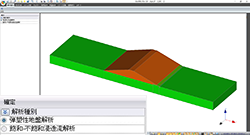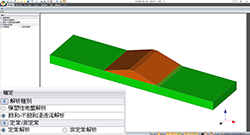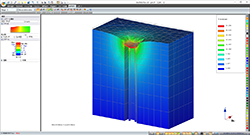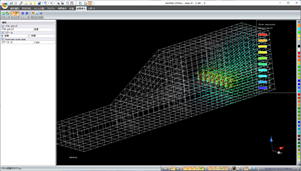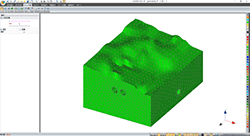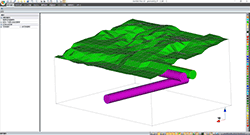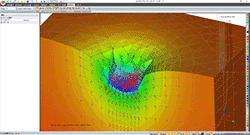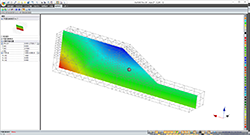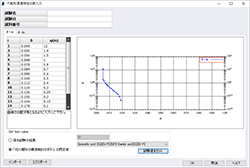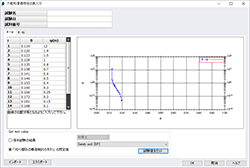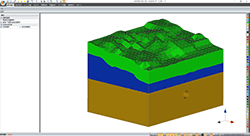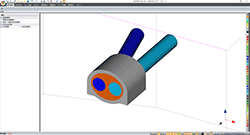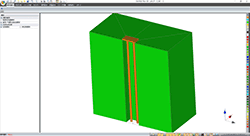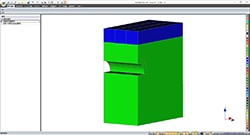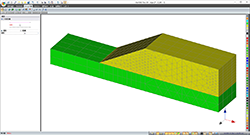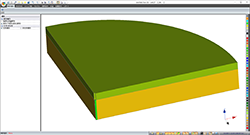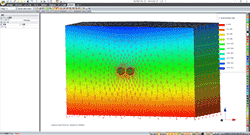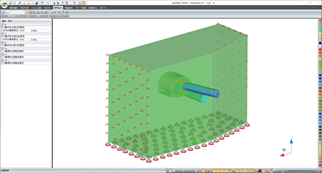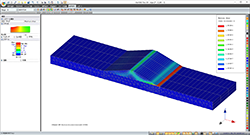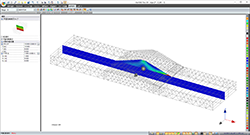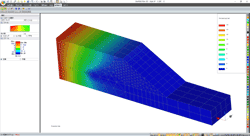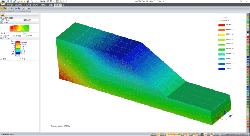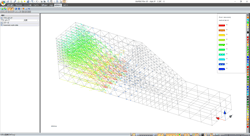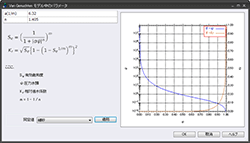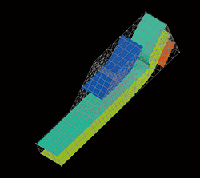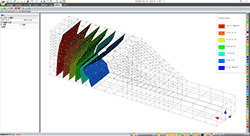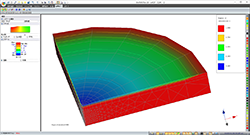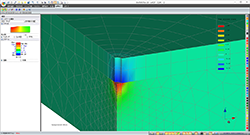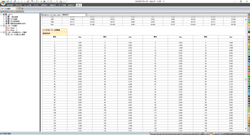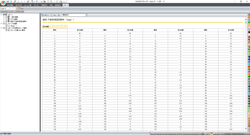Conprehensive software for the elasto-plastic ground analysis and seepage analysis using Finite Element Method (FEM)
GeoFEAS® VGFlow®
Initial Release:2016.06.09
- GeoFEAS® VGFlow®
- USD16,700
- limited to the seepage analysis
- USD7,900
- limited to the elasto-plastic ground analysis
- USD10,500
Program Overview
Elasto-plastic ground analysis by using FEM (GeoFEAS®) and steady/unsteady saturated - unsaturated seepage analysis (VGFlow®) are available in this geometric value analysis program.
In this program, GeoFEAS® and VGFlow® running on the same platform share geometry data and mesh data. This decrease a large amount of work for creating analysis models, which were made on each platform in the previous individual products.
The solver of this product utilizes the ground analysis program developed by the laboratory of ground engineering, Department of Civil and Environmental Engineering of Gunma University. The Pre-Post processor is developed in-house and they are coupled together as a total solution.
*This is an integrated product, but each product can be used separately.
▲Sharing of geometry and mesh
Functions and Features
Creation of model geometry
-
Intersection creation
Intersections can be created between arbitrary objects like solid, surface, and line. even if many structures are intersected intricately.
Group
In 3 dimensions, the number of objects becomes larger than that of 2 dimensions, and model editing becomes more difficult. Grouping of plural objects with the same property value makes it possible to select many objects in a lump and assign material constant.
Display/hiding and confined selection of objects
In the complex 3D model, only the object that you want to edit can be displayed. You can also make a selection from the each of the confined objects of materials, surfaces, and solids.
Import of the terrain data in the LandXML format
You can now import the 3 dimensional coordinate data and its connection information of the point clouds on the ground surface or on the stratum boundary created in LandXML format. Complex terrain information can be built automatically without manual entering, and object structure can also be modeled from the information.
Realistic modeling of the objects like complex terrain and crossed tunnel that can be handled only by the 3 dimension analysis is also available.
Mesh division
-
Mesh is divided semiautomatically. First, set the number of divisions of block line. The line can be divided at regular intervals or in the specified ratio. Surface is parted into triangle or rectangle, and solid is parted into tetrahedron or pentahedron. Model mesh is parted easily even after the number of division has been changed.
Element library
-
Solid elements are used for the ground modeling. Tetrahedron, pentahedron, and hexahedron element are available in this product.
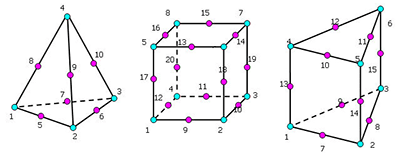
▲Solid elements (tetrahedron, hexahedron, and pentahedron)
Post processor
-
▲Contour figure and plane cut of that
About GeoFEAS®
GeoFEAS®3D is "Geotechnical Finite element Elastoplastic Analysis Software 3D". It is the software product for 3D stress-deformation analysis of soil under static conditions. This FEM product can be used for the elast-plastic analysis in a lot of ground related field such as a pile foundation analysis, earth retaining excavation analysis, tunneling shield, and slope stability analysis.
Applied for
-
- Stress and deformation analysis of the ground
- Slope stability analysis
- Retaining excavation analysis
- Analysis of the effect to the surrounding ground during the tunneling shield excavation
- Tunnel construction study analysis in NATM method
- Study of the effect of changes in the water pressure on the ground
- Study of the interaction between ground and structure
- Seismic response method
Functions and features
-
Stage analysis
Material constant, boundary conditions, and stress release rate during the excavation can be set for the each step of the stage analysis (construction step analysis).
Shear strength reduction method
At each analysis stage, you can calculate overall safety rate by shear strength reduction method and estimate the slip surface. The method can be applied to the 3 full elasto-plastic models.
Local safety rate
This is calculated for each integration point.
Combination of analysis functions
Using some analysis functions together, you can execute the deformation analysis and stability analysis at the same time for a variety of problems related to ground, such as excavation and embankment, and slope stability, support force.
Mixture of the constitutive law
This can be provided to each material.
Type of analysis
Static total stress analysis
Load conditions
This is a program that analyze total stress without regarding permeability phenomenon of the ground. Considering water pressure as nodal load, you can study the influence to the ground exerted by the change in water pressure.
As load types, you can consider node concentrated load, uniformly distributed load, distributed load, and volume load (own weight and static seismic).
Element catalog Structure models Support Concentrated load Nodal concentrated load Yes Distributed load Linear distributed load, plane distributed load Yes Own weight Horizontal acceleration, vertical acceleration Yes Distributed load Constant horizontal load in depth, constant vertical load in depth Yes Horizontal seismic intensity distributed in depth,
vertical seismic intensity distributed in depthNo Water pressure Water pressure on node Yes
Boundary conditions
single point constraint (horizontal roller, vertical roller, fixed, and pin), multi-point constraint (MPC, hinge), and forced displacement are available. Material constant and boundary condition can be set in each stage.
Constitutive law
The most basic method of stress-deformation behavior analysis of soil is using elasto-plastic analysis. It is necessary to select proper element types, constitutive laws, etc.
GeoFEAS® Flow has 15 constitutive laws for soil and structure from the simplest linear elastic constitutive law to elasto-plastic constitutive law. No-tension material is also available. In the Processor, it is possible to perform both deformation and stability analysis at the same time by combining stage and SSR analysis, and to deal with a wide range of soil related problems such as filled/excavated area, slope stability and bearing capacity, etc.
Model types Structure models Note Elastic (1) Linear elasticity Isotropic (2) Laminated elasticity Anisotropic Non elastic (3) D-min Technique by CRIEPI Non-linear (4) HD (Hardin-Drnevich) (5) RO (Ramberg-Osgood) (6) UW-Clay (Ugai-Wakai) Full elasto-plastic (7) MC (Morh-Coulomb) Associative/nonassociative flow rule (8) DP (Drucker-Prager) Associative/nonassociative flow rule (9) MC-DP (Mohr-Coulomb / Drucker-Prager) Nonassociative flow rule Elaso-plastic (10) PZ-Sand (Pastor-Zienkiewicz) (11) PZ-Clay (Pastor-Zienkiewicz) No-Tension (12) Linear elasticity (13) Laminated elasticity
You can apply bi-linear model to the bar element and the spring element, and Mohr-Coulomb method to the joint element. Linear elastic model can be applied to the beam, bar, spring, and joint element.
Output items
Result type Result Contour figure Displacement Stress Strain Max. shear stress Increment of Max. shear stress Compressive stress Tensile stress Local safety rate Total safety rate (only for SSR analysis) Tensor Solid element stress Solid element strain Section force of the plate element bending moment of the plate element
About VGFlow®
Saturated/unsaturated seepage analysis program using Finite Element Method (FEM).
It provides easy ways to generate two and three dimensional complicated shaped geological boundary models, and several functions such as regular meshing, auto-meshing and re-meshing by setting types and dimensions of elements.
Stationary and transient analysis can be conducted. It also supports various boundary conditions, and for unsaturated seepage characteristics, calculations can be made using the van-Genuchten model, which is a typical empirical formula, and by inputting test values such as moisture characteristic curves in a table, and has built-in parameters identified for typical ground in Japan. Various output functions, such as contour, isosurface and vector diagrams, enable wide range of verifications.
Applied for
-
- Check of the rainfall influence against road banks
- Influences of rainfall and spring in large basin
- Measures of seepage surface and water pressure distribution in river levee
- Design calculation of fill type dam body and investigation of seepage on the ground around reservoir
- Examination of permeability in the basic process like curtain grouting
- Design calculation of dam body of reservoir and one for disaster prevention
- Examination of piping and boiling during excavation
- Influences of confined groundwater
- Effect of drainage well on pore pressure distribution in landslide region
- Investigation of seepage in cofferdam
Functions and features
-
- Known hydraulic head
- Known flow
- Leaching
- Outflow forbidden
- Point source
- Fluctuating water level
- Rainfall
- van Genuchten model
- Volumetric water contents θ - Suction ψ, and Volumetric water contents θ - Relative hydraulic conductivity Kr
Type of analysis
Steady flow analysis / Transient flow analysis
Analysis model
3D flow model
Boundary conditions
This product can define the following seven types of boundary conditions and set fluctuating water level and rainfall boundaries at the same time.
Unsaturated seepage characteristics
Library of the material parameter
This program includes the default value for 10 kinds of soil and the library of unsaturated seepage characteristics written on the guideline for structural examination of river embankment.
Output items
Result type Result Contour figure Pressure head Potential Pore water pressure Fractional saturation Volume water content Hydraulic gradient Current speed vector Tensor Current speed vector
Enhancement of CIM function on the geotechnical analysis series products
-
Data linkage using terrain data file (*.GF1) Geotechnical Finite element Elastoplastic Analysis Software (GeoFEAS®)2D Ver.3
The amount of displacement imported to Flexible structure sluiceway design for further analysis
By importing results of ground deformation analysis (settlement / horizontal displacement distribution) to the "Flexible structure sluiceway design", the level2 seismic test for the longitudinal direction can be performed.
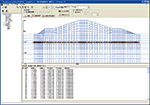

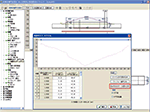
GeoFEAS®2D Flexible structure sluiceway design
It can modelize only ground that a surrounding ground effect analysis is conducted in the Temporary sheathing work design. The ground deformation can be calculated by giving the wall displacement as the forced displacement.Dynamic effective stress analysis for ground (UWLC)
Acceleration rate imported to Slope stability analysis for further analysis
When applying the Newmark method to high embankments with a height of about 30 m or more, it is necessary to input the response acceleration waveform of the slip soil mass as the ground motion.
Data linkage between "Dynamic effective stress analysis for ground (UWLC)" and "Slope stability analysis" corresponds to the Newmark method analysis calculated by using the response acceleration waveform.
The level2 seismic stability calculation for high embankment and large embankment.
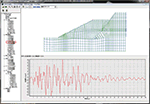

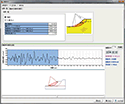
UWLC Slope stability analysis 2-D seepage analysis(VGFlow®2D)
Water line data imported to GeoFEAS®2D
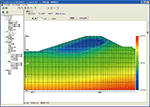

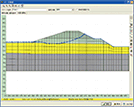
VGFlow®2D GeoFEAS®2D
Water level data imported to UWLC
Water line and potential line imported to Slope stability analysis
Saturated / unsaturated seepage FEM analysis results can be reflected by file linkage (*.PRS [water line], *.PTN [isopotential line]).GeoFEAS® VGFlow® (limited to the seepage analysis)
Water level data imported to LEM3D
Analysis results computed with GeoFEAS® VGFlow® (limited to the seepage analysis) or third party's product can be imported to 3-D slope stability analysis(LEM). It creates underground water level required for landslide analysis and enables the 3D slope stability analysis.
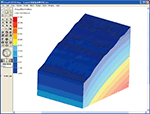

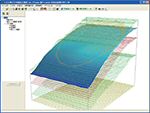
VGFlow®3D LEM3D
Price
Product Price
-
■Product Price
Product
Price
GeoFEAS® VGFlow® USD16,700 GeoFEAS® VGFlow® (limited to the seepage analysis) USD7,900 GeoFEAS® VGFlow® (limited to the elasto-plastic ground analysis) USD10,500 ■Price of Floating License
Paying 40% of the product price allows anyone to use the product on any PC anywhere in the world.
Product
Price
GeoFEAS® VGFlow® USD6,680 GeoFEAS® VGFlow® (limited to the seepage analysis) USD3,160 GeoFEAS® VGFlow® (limited to the elasto-plastic ground analysis) USD4,200
Upgrade
Upgrade Price
-
Program Name Object Product Price/Category Note GeoFEAS® VGFlow® GeoFEAS® VGFlow® (limited to the seepage analysis) USD10,560 Upgrade - GeoFEAS® VGFlow® GeoFEAS® VGFlow® (limited to the elasto-plastic ground analysis) USD7,440 Upgrade - Price of Subscription Service Contract
Price of Subscription Service Contract
-
■Support information
-Software upgrade -Technical inquiry (Email, Tel)
-Download service -Maintenance and update notifications via email
* We are sequentially making a transition from the maintenance-support service to [Subscription Service] from April 1, 2016 in order to enhance support for diverse product usage and to reduce license management cost.
Product Subscription cost
of first yearSubscription cost
of subsequent years
(annual cost)Subscription (GeoFEAS® VGFlow®) Free USD6,680 Subscription (GeoFEAS® VGFlow® (limited to the seepage analysis)) USD3,160 Subscription (GeoFEAS® VGFlow® (limited to the elasto-plastic ground analysis)) USD4,200 Subscription (GeoFEAS® VGFlow® Floating) USD9,352 Subscription (GeoFEAS® VGFlow® (limited to the seepage analysis) Floating) USD4,424 Subscription (GeoFEAS® VGFlow® (limited to the elasto-plastic ground analysis) Floating) USD5,880
Academic Price
An Academic License can be provided for educational purposes and used by teachers, lecturers, academic researchers, and students.
Academic Price
-
Product Academic Price GeoFEAS® VGFlow® USD13,360 GeoFEAS® VGFlow® (limited to the seepage analysis) USD6,320 GeoFEAS® VGFlow® (limited to the elasto-plastic ground analysis) USD8,400 Version Update History
Version Update History
-
■The version upgrade and revision upgrade (without charge) contents are listed as following.
GeoFEAS® VGFlow® Version Release date Update contents 1.0.0 16/06/09 New Release
Product Operation Environment
Product Operation Environment
-
OS Windows 10 / 11 CPU Environments that meet the system requirement of the OS and operate without any problems. Required memory (including OS) Environments that meet the system requirement of the OS and operate without any problems. Required disk capacity About 300MB or more for installation and a few GB for computing. Display (image resolution) 1024×768 or greater is recommended.
Only [Small Font] font size is supported.Input data extension Pre part input data (GF3) File export Post part result data (rsv4) Linkage with other programs <Import>
LandXML topography data file
DXF file
Vertex coordination (XML format)Order / Contact Us
Order / Contact Us
-
■ Inquiry
Contact us from Sales inquiry or email to ist@forum8.co.jp or forum8@forum8.co.jp
Sample screen
Q&A(製品評価や導入の際に役立つQ&Aです)
- 何ができるのか?
-
3次元汎用解析ツールとして、2次元モデルから3次元立体フレームモデルまで作成可能です。
また、板要素を使用したFEMモデルも作成可能で、部材は線形要素から非線形要素まで、荷重も静的荷重から動的荷重まで対応可能となります。
- どのような計算に活用できる?
-
橋梁の静的解析や動的解析、河川構造物の耐震計算や水道施設の耐震診断、建築構造物の計算に活用できます。
また、他社にない機能としまして弊社のUC-1設計シリーズの橋台・橋脚・基礎・震度と連携して、保耐法の計算データから動的解析が可能なデータを自動生成可能です。
- 報告書として成果に活用可能?
-
もちろん可能です。ただし対象を桁橋や直線橋などに限定していませんので、出せるものは計算書レベルの出力となります。
Excelへのカット&ペーストが可能ですので報告書のひな形へ貼り付けながら結果をとりまとめることが可能です。
- どのような基準に対応している?
-
橋梁設計で使用される道路橋示方書のH14年版、H24年版、H29年版に対応しています。
また、断面照査ではコンクリート標準示方書の限界状態設計法にも対応しており、構造物の照査まで可能です。
- どのグレードを購入すればよい?
-
線形解析、静的解析メインの方はLite版、フレーム解析で非線形解析、動的解析まで必要な方はadvanced版、非線形のFEM解析が必要な方はultimate版をご購入下さい。
- 入力について不明な場合は?
-
製品ヘルプもしくはHPに電子マニュアルに製品詳細と操作法を準備しております。その他、定期的に開催される有償セミナーでは静的解析モデル、動的解析モデル、FEMモデルの3つのモデル化の講習が受講でき講師と質疑応答も可能です。また有償となりますが、計算モデルを作成する解析支援サービスもあり年間100件を超える実績がございます。
解析支援サービス:https://www.forum8.co.jp/product/ucwin/ES/ESkaiseki.htm>> サポートページ Engineer's Studio® Q&A集

LOADING

